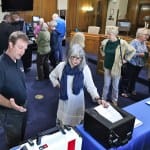Election equipment vendor choice for Monroe County still getting mulled by board, vote centers unlikely for 2020




The Bloomington city council’s most recent regular meeting fell on Nov. 6, the day after municipal elections were held in Bloomington for just two of six council districts.
Elections had been cancelled by the election board in the other four districts because races were uncontested there. None of the citywide races—mayor, clerk, or at-large city council seats—had more than one candidate on the ballot and no write-in candidates were registered.
A couple of councilmembers on Wednesday mentioned vote centers, as opposed to precinct polling stations, as something that should have been tried, so that elections could have been held everywhere, without incurring too much additional expense.
Asked by The Beacon on Friday, the election board chair, Carolyn VandeWiele, said that completing the statutory process for establishing vote centers for this year’s municipal election, even starting in July, would not have been feasible. It’s also probably not practicable for 2020, she said.
Of more immediate concern is the acquisition of new voting equipment.
Responding to a question about the timetable for selecting a vendor for the county’s new election equipment, VandeWiele said on Friday the committee making the selection was behind the optimal schedule outlined in the county’s request for proposals (RFP). The timetable in the RFP foresaw a vote on the recommended vendor by the county commissioners by their Nov. 6 regular meeting.
The committee is still waiting for answers to questions that it has asked of the state’s election division and the vendors themselves. VandeWiel also said the committee is checking references for the two vendors. The next meeting of the vendor selection committee is scheduled for Nov. 18, she said.
VandeWiel told The Beacon that even if the committee is right now a little behind the optimal timeline laid out in the RFP, “We won’t be behind when it comes to having equipment for the spring…We still have a fair amount of time to deal with this. We will have the equipment on time. It’s just a matter of making sure we’ve crossed all the t’s and dotted all the i’s.”
That assurance came in the context of a question about the 2011 municipal election, pre-dating VandeWiel’s service on the election board. That year Monroe County found itself without the optical scanners needed to tally votes by machine. Even the plan to hand-count ballots had to be revised within a couple days of the election, to conform to the state statute that requires hand-counted ballots to be tallied at the polling sites.
This year the county commissioners had initially included $1 million of the annual general obligation bond to cover election equipment, but now plans to pay for it out of cash reserves.
By the Oct. 22 deadline, two proposals were received to the RFP issued by Monroe County: Hart Intercivic, out of Austin, Texas; Election Systems & Software (ES&S), out of Omaha, Nebraska.
In the RFP, a scoring system is described for evaluating proposals. Satisfaction of basic voting system requirements counts for 30 percent of the score. The implementation plan also counts for 30 percent, and includes items like support while voting is going on, the lines of communication, and software updates. Experience counts for 10 percent of the score. Cost is 30 percent of the score.
The composition of the committee, according to the RFP, is supposed to include one county commissioner, a county councilor, the three members of the county’s election board, a representative from the League of Woman’s Voters, and a representative from the county’s legal department.
Vote Centers
A vote center is a polling place where any eligible voter in the county can vote. They’re connected through the internet, so that when someone votes, the electronic poll books at all centers are updated, to prevent someone from voting more than once.
Generally, the vote center approach is supposed to cost less because fewer polling sites, thus fewer voting machines and fewer election workers are needed. Convenience for voters is also a benefit that is touted for vote centers.
At the council’s meeting last Wednesday, Bloomington city councilmembers Dorothy Granger and Jim Sims both mentioned vote centers as an option that should have been tried for this year’s municipal elections.
The expense argument was one that councilmember Jim Sims said had persuaded him initially that elections shouldn’t be held in places where no races were contested. But on Wednesday, he said he thought it would have been better to have had a centrally located vote center so that people who wanted to cast a ballot in an uncontested race could have done that.
Granger said this year would have been a perfect opportunity to try vote centers, saying it’s something that’s been talked about before.
On the question of vote centers, VandeWiele told The Beacon she generally supports them, but there is a lot of work that would still need to be done to establish vote centers for Monroe County. She told The Beacon that it would not have been possible to complete the statutory process in time for Bloomington’s municipal elections this year.
Indiana’s secretary of state’s website outlines seven steps for establishing vote centers: resolutions passed by county council and county commissioners; formation of a study committee; drafting a vote center plan; 30-day public comment period; election board approval; filing of plan with the state.
Of Indiana’s 92 counties, 39 of them have adopted a vote center approach.
The idea of vote centers is not new in Monroe County. In December 2011 the election board voted 2–1 in favor of them. But it requires a unanimous vote on the three-member board. The current board includes the county clerk, Nicole Browne, a Democrat, which is the slot VandeWiele fills, and a Republican, who is Hal Turner.
Browne responded to an emailed question from The Beacon about the prospects of vote centers for Monroe County by saying she would support them in Monroe County. But she does not think there is the required unanimous support on the election board for vote centers.
For his part, Hal Turner did not state opposition to vote centers in principle, but described several issues that he thinks need to be studied, like the question of whether vote centers would actually save money in Monroe County. The possible inconvenience to some voters also needs to be considered, he said. He also cited as crucial the accessibility issues of the vote center sites.
Randy Paul, a long-time advocate for the disability community, told The Beacon that back in 2011 most of the proposed vote center sites at that time were not accessible. He’d chaired a group that delivered a report on it, he said. The lack of accessibility of sites in the vote center plan was a reason that Judy Smith Ille, the Republican member on the election board at the time, voted against vote centers, according to Paul.
Turner summed up by saying, “I think [vote centers are] beyond the scope of something we could do before the 2020 election, less than a year away. But it does need to be looked at.”




Comments ()